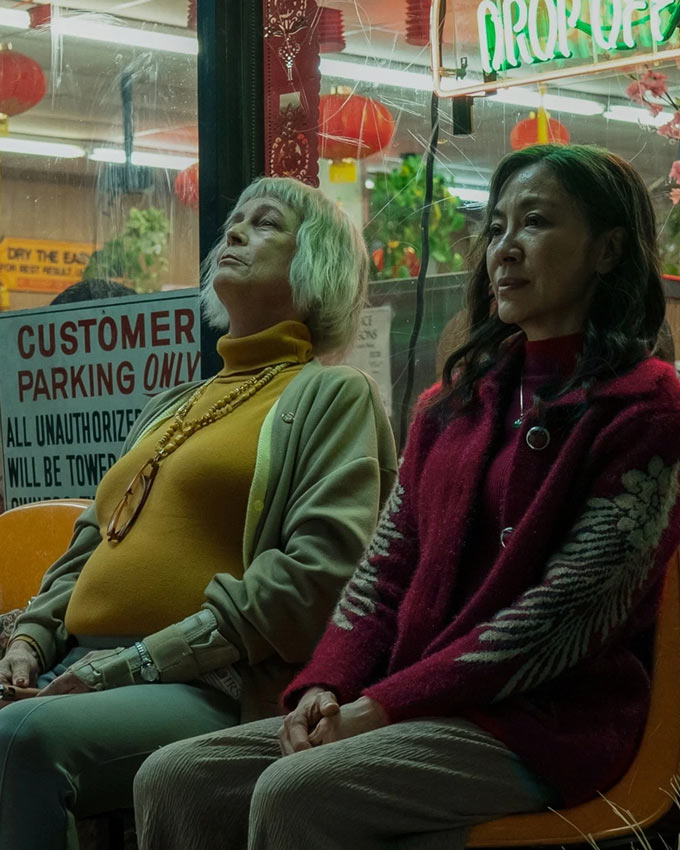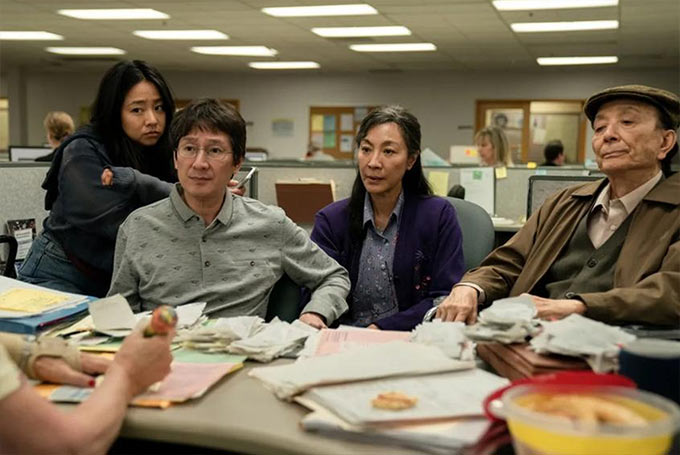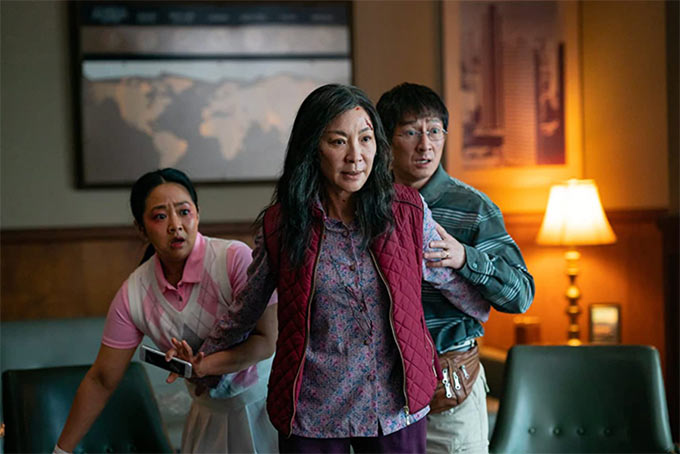Disclaimer: This article contains spoilers about A24’s ‘Everything Everywhere All At Once’.
In Everything Everywhere All At Once, Michelle Yeoh plays my mother. Well, not technically—Yeoh’s character, Evelyn, is a Chinese-American immigrant with a teenage daughter; my mother is Chinese-Australian, and I like to think my teenage years are far behind me. But these are superficial differences. In every other way, Yeoh is my mother’s mirror image: the sharp focus she applies to the task at hand, which in the best of times is formidable, and in the worst of times, myopic. The strength she wears in her posture, which in moments of respite, flickers. There’s a heaviness on her shoulders that weighs more than she lets on.

If you haven’t already watched A24’s newest film, the brainchild of directors Daniel Kwan and Daniel Scheinert, please do so at your earliest convenience before you continue reading. It is the best movie I have ever watched. I understand this is quite the claim, but Everything Everywhere All At Once is a cinematic behemoth. In the space of two and a half hours, what begins as a quiet study of Evelyn’s tax troubles broadens into a full-blown, sci-fi epic that sees Evelyn mind-travelling (or ‘verse-jumping’, as the movie calls it) into alternate selves from other universes. Genre is a plaything for the two Daniels heading the project. The story volleys between comedy and melodrama, and makes references to everything from Ratatouille to wuxia to Wong Kar-wai’s In The Mood For Love. Above all, it juggles with modern nihilism, and rolls philosophy’s hardest question around on its tongue:
Why should we believe in anything, when nothing really matters?

To zoom in so closely on the film’s mother-daughter relationship, then, might seem too narrow, but the tension between Yeoh’s Evelyn, and her only child Joy (played by Stephanie Hsu)—along with her marriage to sweet husband Waymond (the marvellous Ke Huy Quan)—is the driving emotional force. I single their dynamic out because I’ve never seen a film which portrays my own experience so deftly. I saw as much of myself in Joy as I did my mother in Yeoh. Joy is lost. She’s young and angry. The only thing she wants is for her mother to understand her, but their cultural distance causes them both immense pain. There’s a scene early on, when Joy is attempting to introduce her girlfriend Becky to her grandfather (James Hong), and reverts to broken Cantonese. She fumbles around in the dark for the correct words, before Evelyn cuts in. “She’s a good friend,” Evelyn says placatingly, much to Joy’s chagrin. It reminds me of many times when I have misinterpreted my mother’s words and vice versa, the assumptions that were made and the tears that often followed. One of the hardest sacrifices a parent can make for a child is their own mother tongue.

Joy’s narrative is a familiar one, as far as diasporic metaphors go. Her hurt and rage devolve into total disillusionment, and in an initial twist, position her as the multiverse’s villain, hunting down her mother’s various alternate selves across realities under the alias Jobu Tobaki. She straddles the schism between her wants and her mother’s expectations, the East and the West; it’s a tale Hollywood has recently become comfortable exploring with Crazy Rich Asians, The Farewell and Pixar’s Turning Red, which have paved the way for Asian-led projects like this one.
But what sets Everything Everywhere All At Once apart is that it tells the story from the mother’s perspective. Even in films where cultural anxiety is the centrepiece, the Asian mother—ever-worrying and helicoptering around her Westernised daughter—diverges little from stereotype. Everything Everywhere All At Once, on the other hand, devotes overwhelming complexity to Evelyn. Evelyn is the hero, bristling with hubris and torment. She withers under the glower of her disapproving father, who disowned her for moving to America with her husband. She wonders what her life would be like if she hadn’t left with Waymond—if she would be doing ‘more’ than owning a laundromat and doing taxes. The film makes it clear that the pain Evelyn inflicts on Joy, both knowingly and unknowingly, has a source. She’s in pain herself, cut on the pieces of a reality she feels was stolen from her. It feeds her daughter’s confusion, and infects her marriage with Waymond. Evelyn only practises the trauma that bleeds through her family tree.

Most significantly, Everything Everywhere All At Once doesn’t absolve Evelyn of accountability. She has hardened herself, and as a result, is often blind to the hurt she causes; in the film, the impact of this hurt manifests itself in a maelstrom of interdimensional chaos. Instead, Everything Everywhere All At Once bridges a gap in understanding between the many Evelyns and the many Joys that make up this universe alone. Without spoiling too much, Evelyn ends the film redeemed. Not fully at peace, but at peace with the important things. The first thing I wanted to do when the credits began rolling was to hug my mother and tell her I loved her.
As I do after watching any film, I combed through reviews from critics immediately afterwards—not looking for anything in particular, just seeing the sights. (I read one that implied the film was bathetic—which ironically, is exactly the brand of cynicism the film cautions against.) Of all the essays, it was R.F. Kuang’s on Tor that stuck with me the most. Kuang calls the film a “non-diaspora diaspora film”—a story where Asian identity doesn’t prima facie constitute the plot, but is integral regardless. Why Everything Everywhere All At Once is so refreshing, Kuang argues, is that it goes beyond traditional questions of belonging and non-belonging.
“What if we instead leaned hard into hybridity?”, Kuang asks. “What if we dispensed with all the hand-wringing about cultural authenticity and representation and loyalty and over-explaining ourselves to a white audience who might not get where we’re coming from and just… stuck some googly eyes on rocks?”

This, by the way, is precisely what happens in the rock-verse of Everything Everywhere All At Once, my personal favourite universe of the many we glimpse in the film. There, Evelyn and Joy are just two rocks, overlooking a valley of rocks from atop a rocky cliff. The film is silent for this scene, the dialogue, printed in text across the sky. After an hour of kaleidoscopic noise and colour, the film takes a breath. It sheds its skin. These are its bare bones: a mother, and her daughter, existing together. Nothing else matters.
This story was originally published on Vogue Australia.





